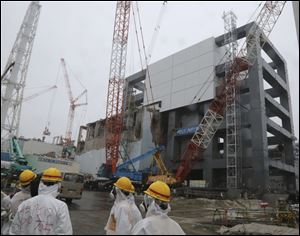
Japan OKs fuel rod removal from pool at nuclear plant
10/30/2013
The steel structure for the use of the spent fuel removal from the cooling pool is seen at the Unit 4 of the Fukushima Dai-ichi nuclear plant at Okuma in Fukushima prefecture, Japan in June.
TOKYO — Japanese regulators today gave final approval for the removal of fuel rods from an uncontained cooling pool at a damaged reactor building considered the highest risk at a crippled nuclear plant.
Removing the fuel rods from the Unit 4 cooling pool is the first major step in a decommissioning process that is expected to last decades at the Fukushima Dai-ichi plant, where three reactors melted down after the March 2011 earthquake and tsunami.
The Nuclear Regulation Authority said at its weekly meeting that the proposal by the plant’s operator, Tokyo Electric Power Co., is appropriate and that the removal can start in November as planned, following an on-site inspection by regulators.
“It’s a major step toward decommissioning,” said Toyoshi Fuketa, one of the authority’s five commissioners. “Moving the fuel rods out of Unit 4 can significantly reduce the risk at the plant.”
The Unit 4 reactor was offline when the plant was hit by the disasters, but the building was damaged by hydrogen explosions and fire. Fuel rods in the pool, however, have since been properly cooled and are safe enough to remove, officials said.
TEPCO has reinforced the structure around the pool and says the Unit 4 building can survive a major earthquake, but the unenclosed pool on the unit’s top floor, which contains 1,533 fuel rods, has caused international concern. About 200 of the rods that are unused and safer are expected to be the first to be removed.
The Unit 4 cooling pool has attracted international attention in part because early in the crisis it was suspected to have dried up, when in fact there was enough water to cover the rods, keeping them from melting. TEPCO last year plucked two unused fuel rod units out of the pool and said no major corrosion or damage was found in them.
Nuclear regulatory chairman Shunichi Tanaka, however, warned that removing the fuel rods from Unit 4 would be difficult because of the risk posed by debris that fell into the pool during the explosions.
“It’s a totally different operation than removing normal fuel rods from a spent fuel pool,” Tanaka said at a regular news conference. “They need to be handled extremely carefully and closely monitored. You should never rush or force them out, or they may break.”
He said it would be a disaster if fuel rods are pulled forcibly and are damaged or break open when dropped from the pool, located about 30 meters (100 feet) above ground, releasing highly radioactive material. “I’m much more worried about this than contaminated water,” Tanaka said.
TEPCO has prepared a massive steel structure that comes with a remote-controlled crane to remove the fuel rods, which will be placed into a protective cask and transferred to a joint cooling pool inside a nearby building. To make room for the Unit 4 fuel rods, the company has been moving those already in the joint pool to safer storage in dry casks at a separate plant location.
The utility plans to empty the Unit 4 pool by end of 2014, and remove fuel rods from other pools at three other wrecked reactors over several years before digging into their melted cores around 2020.
The Fukushima plant has had a series of mishaps in recent months, including radioactive contaminated water leaks from storage tanks, adding to concerns about TEPCO’s ability to safely close down the plant.